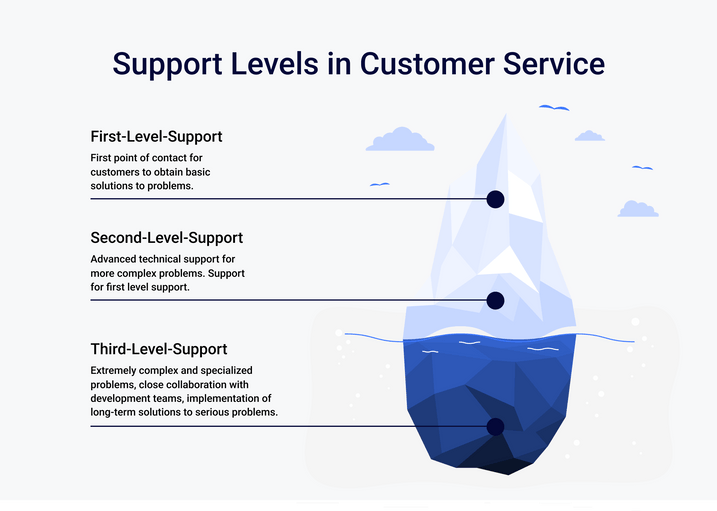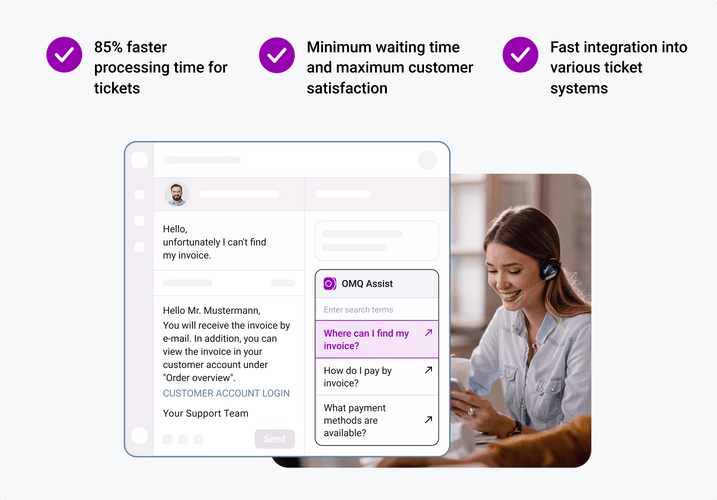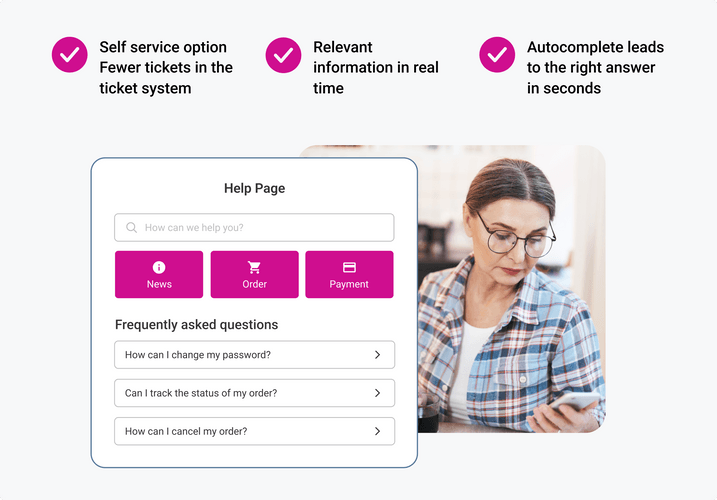Customer Service
First Level Support - Expert knowledge and tips
What does first level support really mean & how to deal with customer queries. Experts share tasks, benefits and best practices.

First Level Support Definition
First Level Support is the first point of contact for customer inquiries, technical problems, questions or faults. This support level aims to solve basic problems immediately or to forward them to second level support or various specialist departments departments if specialist knowledge is required.
Tasks include the recording and classification of requests, the implementation of simple troubleshooting and documenting all interactions. It is crucial for effective customer service and customer satisfaction.
Support level in customer service
First Level IT Support
Examples of first-level support tasks include resolving login problems, installing software or providing instructions on how to use devices. In case that a problem cannot be solved by first-level support, it is passed on to second-level support. This area of customer service is crucial for customer satisfaction, as it is often the first point of contact with the company.
First und Second Level Support
“Customer service” is a central aspect in companies and can be divided into different levels. First Level Support is the first point of contact for customer inquiries. It answers simple questions, solves basic problems and forwards more complex requests. The second level support is more specialized and deals with more complex problems that first level support could not solve. It requires in-depth specialist knowledge and often includes technical support. Both levels are essential to ensure efficient and effective customer service.
Third Level Support
Third Level Support is the highest level of customer support within a company. In contrast to first level support, which is the primary handles support requests, and second level support, which solves more complex problems, third level support is highly specialized and responsible for solving technically demanding problems.

Support levels in customer service.
First Level Support Tasks
First Level Support is the first point of contact for users who need help and has the following tasks: Identification of problems, recording support tickets, solving simple problems, forwarding more complex requests to second-level support, communication with the end customer regarding the request status, careful documentation of measures and solutions as necessary training and providing instructions to help users solve problems independently.
Tasks of the first level support include…
- Problem identification: Requests are received from users and the nature of the problem is identified.
- Capturing tickets: Creating support tickets is an important task. First-level support records all relevant information into one issue to document the entire support process.
- Basic problem solving: Simple problems are solved. This can be through providing guidance, instructions or carrying out basic troubleshooting steps. Depending on the difficulty of the issue, the technical support process can be ended here.
- Forwarding to specialists: If the problem is more complex or requires specialist expertise, first-level support will forward the request to second level support or other specialist departments.
- Communication with customers: First-level support keeps customers updated on the status of their request.This includes deployment updates, estimated resolution times and other relevant information. If difficulties arise, patience is also required on the part of employees and customers.
- Documentation: Careful documentation of the measures and solutions implemented is crucial. This enables efficient collaboration with higher support levels and serves as a knowledge base for future reference.
Challenges in first level support
Variety of customer requests
First level support teams must handle a wide range of requests, from simple questions to complex technical problems. This requires diverse skills and a good knowledge base.
High volume of inquiries
The diversity of customer inquiries is often accompanied by a high volume of inquiries. This leads to long waiting times and increased Pressure on the support team to answer these customer inquiries quickly and efficiently.
Time pressure
Customers expect quick solutions and often have little patience. As already mentioned, this increases the pressure on the service employees and can also lead to complex problems not being able to be dealt with adequately.
Technological challenges
Customer support has to deal with a variety of technologies, platforms and applications as part of their job. The rapid technological change requires continuous training to stay up to date.
Communication skills
Good communication skills are crucial to conveying technical information to customers in an understandable manner. Support staff often have to be able to translate complex technical concepts into simple language.
Emotional stress
Customers experiencing technical issues may become frustrated or annoyed. First Level Support must be able to deal with customers professionally and empathetically, even in stressful situations.

Service agents face a lot of pressure in customer service.
Improvement of first level support
First-level support can be improved in various ways. Tools that work most effectively are those that can assist service employees in answering customer inquiries. This not only ensures that employees answer more efficiently, but also for greater satisfaction for the customer.
Tools such as help pages, chatbots and ticket systems are ways to help customers quickly answer standard questions help and thus improve support processes.
Chatbot
Chatbots provide support teams with the benefits of scalability by enabling a large number of Can process requests at the same time. Their 24/7 availability enables users to receive 24/7 support, regardless of working hours or time zone. With fast response times, you reduce waiting times and can perform repetitive tasks automate, increasing efficiency and reducing support team workloads. Additionally, chatbots deliver consistent answers, improve the quality of support and help reduce misunderstandings.
In addition, chatbots enable improved analysis of support requests and can provide valuable insights into frequently occurring problems as well as deliver customer needs. This data can be used to optimize processes, improve products and the to increase customer satisfaction in the long term.
Ticket system
When a customer submits a support request, a ticket is created that contains all the relevant information about the request, such as the customer’s name, the nature of the problem, the ticket date and a unique ticket number. These tickets are then processed by the support staff, who prioritize them according to their urgency and relevance.
The ticket system enables support teams to keep track of all ongoing requests, tracks the status of each request, adds updates and documents customer feedback. This ensures efficient and transparent processing of support requests efficiently and enables faster problem resolution for customers.

Automated ticket system for customer service.
Automated help page
In Self Service, customers can find answers to their questions themselves. Automated help pages in customer service offer a user-friendly platform for customers to find answers to frequently asked questions and solve problems independently. These resources include guides, FAQs and video tutorials that help customers help customers resolve their concerns quickly. By utilizing these self-help options, support teams can be relieved, resulting in shorter waiting times for customers and allows the support team to focus on complex requests that require human intervention. Overall, automated help pages help to increase customer satisfaction and reduce operating costs.
In addition, automated help pages enable continuous availability of information, as customers can access resources at any time of day or night. This helps to increase customer satisfaction by providing customers with fast and straightforward support, while improving the efficiency of the support team and reducing operating costs.

Advantages of an automated help page.
Customer service automation and first level support
Customer service automation supports first-level support by automatically processing simple and recurring requests. For example, chatbots can answer basic questions or solve common problems, which reduces the workload of support staff. This allows employees to focus their time on more complex requests and ensure a faster response time for customers. Automation also improves the efficiency and scalability of first level support, as it provides the ability to handle a large number of requests simultaneously without the need for additional human resources.
Conclusion
First Level Support serves as the initial point of contact for customer inquiries, technical issues, and disruptions. Its tasks include identifying and classifying inquiries, resolving basic problems, and escalating more complex issues to the Second Level Support. Efficient management of this support is crucial for positive customer service and high customer satisfaction.
The challenges in First Level Support, such as the diversity of customer inquiries, high volume of requests, and time pressure, require versatile skills and effective tools. Improvement possibilities include the utilization of help pages, chatbots, and ticketing systems, which can enhance efficiency and optimize the customer experience.
By integrating automation technologies such as chatbots and leveraging AI tools, support teams can be relieved while ensuring faster response times and transparent handling of inquiries. Continuous optimization of First Level Support is thus crucial to meet the growing demands of customer service and ensure high customer satisfaction.
Optimization of first level support with OMQ
The OMQ system offers holistic service optimization thanks to various AI tools. For more information, please contact us. You can also schedule a demo without obligation, where we can advise you on your case.


